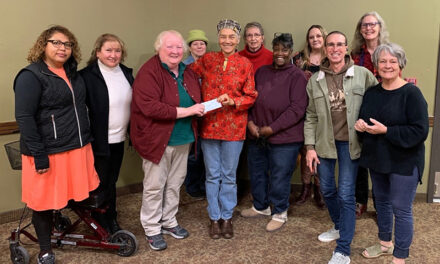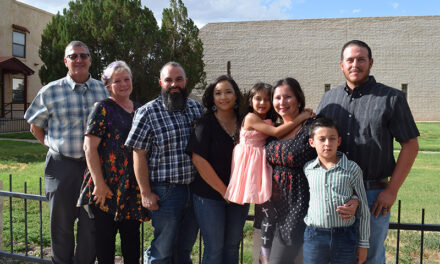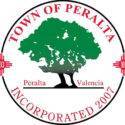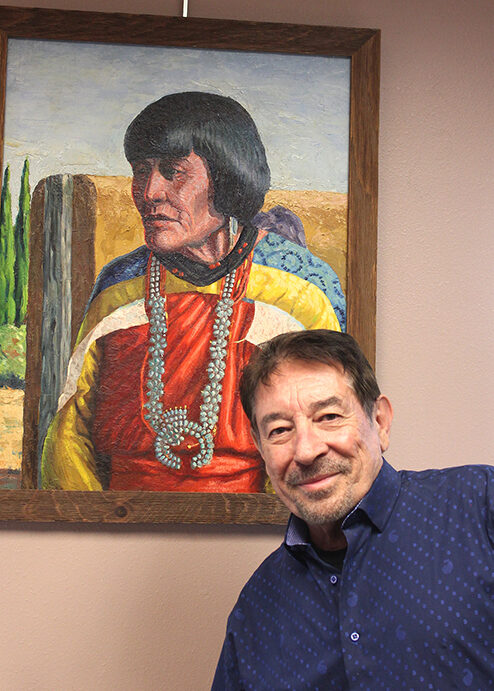
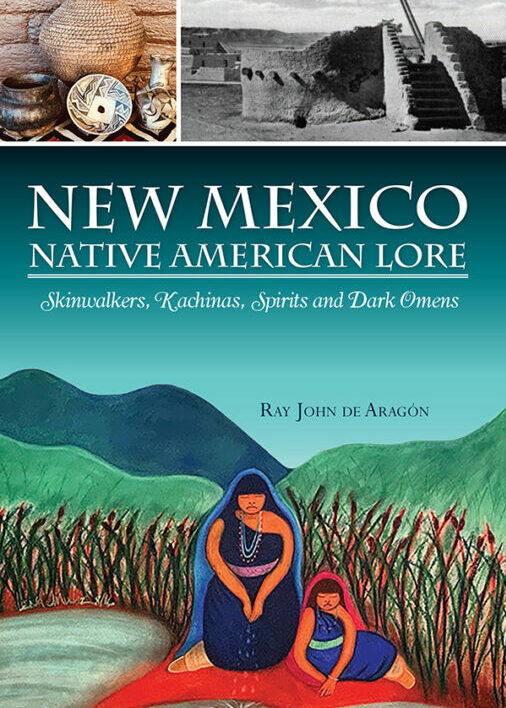
Makayla Grijalva | News-Bulletin photo
Left, Ray John de Aragon, who traces his family history back to Valencia County, recently released his 21st book, “New Mexico Native American Lore: Skinwalkers, Katchinas, Spirits and Dark Omens.”
Photo courtesy of Lena J. Munoz
Right, “Morning Blessing” is a pastel and mixed media by Lena J. Munoz, who received her Bachelor of Arts degree in studio art from the College of Santa Fe. Indian spirituality is shown though prayer, placement of hands and the body of motion. The painting is one of many illustrations in Aragón’s book, “New Mexico Native American Lore: Skinwalkers, Kachinas, Spirits and Dark Omens.”
From the legend of the Salt Woman to the systematic hunting of the buffalo by American settlers, New Mexican author and ethnohistorian Ray John de Aragón released his 21st book, “New Mexico Native American Lore: Skinwalkers, Katchinas, Spirits and Dark Omens.”
“I think this one should open up a lot of eyes …” Aragón said. “It’s opening up many doors in my writing career, and I think it’s because people are interested in the spirituality of the Native Americans to explore completely.”
The book hit the shelves of major bookstores, such as Amazon and Barnes and Noble, on Aug. 15. It features the art of Los Lunas artist, Lena J. Munoz, who studied at the Institute for American Indian Arts in Santa and has some pieces showcased in the Isleta Casino and Resort.
While Aragón was born and raised in Las Vegas, N.M., he has roots in Valencia County with family descending from both the Los Chavez and Tomé land grants.
First learning about his family’s history sparked a lifelong curiosity about history, especially histories centric to New Mexico and the Native people who have called the state home for thousands of years.
“I was always interested in history because my dad was always telling us about our ancestry. He always spoke about our genealogy,” Aragón said. “Just as a young kid, I knew who my grandparents were, but I wanted to know who my great-grandparents were and who my great-great grandparents are and take it back as far as I could.”
This curiosity inspired him to ask questions and learn stories about his family from relatives, eventually gathering enough information, photographs and documents to create a detailed family history.
His love of history expands beyond his own family, with Aragón also taking interest in Native American, and Mexican and South American Indigenous history.
“In my case, I’ve always been interested in Native American history — the Aztecs, the Mayans, the Toltecs, the Incas,” he said. “Then I was particularly interested in southwestern Native American history and now branching out into American Indian history.”
His interest grew since his childhood home was filled with Native American art, such as blankets and pottery his father would collect during his adventures as a traveling salesman.
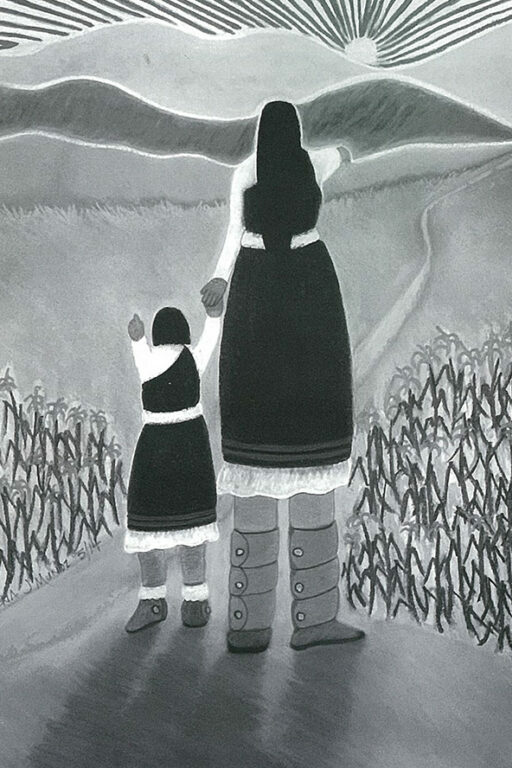

Aragón’s career as a writer began in high school when he wrote articles published in local publications around the state, such as the Las Vegas Optic.
He also began competing in writing competitions around this time.
When Aragón began attending college at the University of Albuquerque, he had already developed a love for writing, but began looking critically at the texts he was assigned to read for class.
“When I was a student at the university, I read ‘Death Comes for the Archbishop’ in English class,” he said. “When I read that, I was incensed at what this writer said because it contradicted everything I had heard.”
He began delving into the history behind the book, eventually publishing his first book, “Padre Martinez and Bishop Lamy,” in 1978 which contradicted the portrait painted by Willa Cather of the two individuals at the center of her novel.
“When you are a historian, you wind up coming across selective history,” Aragón said. “Many historians write selective history. They write about what they would like people to know, so they leave a lot of information out.”
Aragón dedicates his books to telling the real story about what happened, focusing on primary sources, such as letters and newspapers written during the time period he is studying.
“I found out there was a great deal of misinformation and fallacious history that actually didn’t happen,” Aragón said. “You read that in any history because of bias, racism, prejudice, it comes into play. And so they all elevate and glorify a certain history to promote what they are writing about and that’s what wound up happening with the Native Americans, of course.”
One example that Aragón pointed out, which he goes into more detail within his newest book, is the reason why the buffalo nearly went extinct. American settlers organized extensive hunts, with hunters being paid for every buffalo killed, in order to eliminate a critical food source for some tribes.
Aragón said he loves tracking information through primary sources because it paints a better picture of the time period being researched, with more information being released by the federal government not previously available.
The author has already begun working on his 22nd book. Although he cannot yet divulge the specific stories he will expand upon, he said it will be about festivities and celebrations central to New Mexico.
Aragón will be the keynote speaker at the upcoming New Mexico Press Association conference in Santa Fe in November.
Makayla Grijalva was born and raised in Las Cruces. She is a 2020 graduate of The University of New Mexico, where she studied multimedia journalism, political science and history.

